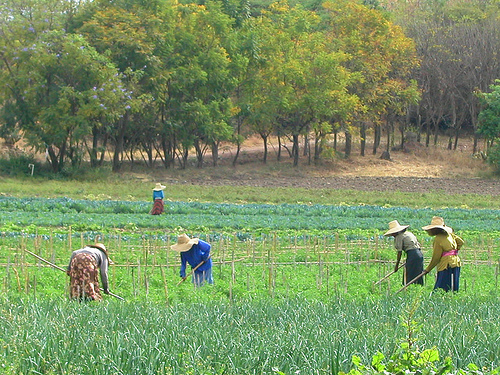Forced Labor, Child Labor and Debt Bondage
The two words, “slavery” and “shrimp”, seem an unlikely combination, with little or no relevance to one another. In fact, the element of “modern-day slavery” in the processing of shrimp is something that has sparked a report from the Solidarity Center called, “The True Cost of Shrimp”.
The Solidarity Center, a nonprofit organization that represents the outreach efforts of the American Federation of Labor-Congress of Industrial Organizations (AFL-CIO), was established in 1997. It attempts to provide “equitable, sustainable, democratic development … to help men and women everywhere stand up for their rights and improve their living and working standards.”
It’s a noble ambition in a world comprised of the 99 percent, where vastly more than half make just enough to sustain life. And if the title of the report strikes a chord in memory, it’s probably due to a series of articles in 2008 called, “The True Cost of Blue”, which also examines how production (denim jeans, in the latter case) impact the people and the environment in the places where they are manufactured.
The blue jeans industry involves “maquiladoras”, or sweat shops where desperate Mexican workers earn just enough to keep themselves (and their families) alive. The shrimp industry is even worse, providing less than a living wage while it harvests shrimp using child labor, forced labor and debt bondage – this last the result of allowing workers to purchase more (from the company stores) than their work earns. This results in their owing more money than they can ever repay, and prevents them from seeking better jobs.
It’s such a subtle form of slavery, harkening back to the early days of American coal mining in Appalachia, when miners bought goods from a “company store” at premium prices and were for ever after little more than indentured servants to the coal company. But at least the workers, some of them children and young adults, applied for the jobs instead of being forced into them to survive.
Shrimp Slave Countries across Southeast Asia
Laos, Myanmar, Thailand and Vietnam are all located within the “Golden Triangle” of Southeast Asia. In terms of economies, Vietnam is at the top of the barrel, and Myanmar is at the bottom. According to Mark Lagon, head of the U.S. State Department’s Office to Monitor and Combat Trafficking in Persons, debt bondage (as illustrated above) is modern slavery, and those in the U.S. who buy shrimp need to know that their can or frozen package of delectable crustaceans was packed “by the hands of those in slavery.”
In an effort to alleviate the situation, the Solidarity Center has been in contact with both shrimp processors and local governments in the area. This means Thailand, which exported $1.3 billion worth of shrimp in 2006, and its closest competitor, Bangladesh, which exported $200 million, putting it ninth in terms of shrimp exporters.
Vietnam, whose economy is exploding, has diversified enough not to need a place on the list. India – which exported 17,443 tonnes in the first full quarter of 2013 – is already on track to beat 2012 shrimp exports by 69 percent! For a closer comparison, note that India exported 5,404 tonnes in March, 2013 as compared to 3,075 tonnes in March of 2012.
Haste Makes Waste
As happens everywhere across the planet, when workers are bound in debt servitude and forced to work faster than is humanly possible, accidents happen – sometimes horrific accidents.
Unfortunately, in places like India, Myanmar – even Thailand – personal injury claims are nonexistent. Complain about an injury, and there are at least 10 people waiting to take one’s job.
Even where workers are voluntarily employed, they make about $5 per day for a six-day week, which barely covers the cost of rice, vegetables and perhaps a little meat on holidays, let alone enough wood or fuel to cook the meager meal of the day and, in winter, enough pirated electricity to allow children to study their lessons. Even those workers who have the energy to work overtime seldom see overtime pay, but most know better than to complain.
Though the National Fisheries Institute has said that it takes reports of worker mistreatment very seriously, it also cautions consumers against “painting the entire industry with a broad brush” because of a few rotten corporate apples in the barrel.
That said, consumers might also be interested to note that, according to the Solidarity Center, Thai shrimp were sold under a number of brands by large, chain grocery stores like Costco, Cub Foods, Giant, Giant Eagle, Harris Teeter, IGA, Trader Joe’s and Wal-Mart.
The Weight of Consumer Protests
Over the past three decades, successful consumer boycotts have produced highly positive results with such companies as Coca-Cola; Libby’s fruit juices; cotton traders working out of Burma; Shell’s sponsorship of Wildlife Photographer of the Year; Staples (getting into the recycled paper campaign); and the slaughter, manufacture and sale of fur coats.
And don’t forget the most famous boycott in history, the Boston Tea Party of 1776. Even though the English, Irish and Scots immigrants who settled America loved their tea, they loved their country more. To prove it, they dumped all the imported tea into the harbor, considering bitter coffee made from burnt toast a fair price to pay for freedom.
About the Author:
Andrew Miller is a passionate member of the End Ecocide movement, an avid legal blogger, environmental law student and co-founder of the tech startup Scanandban.com









my husband was looking for a form recently and learned about an online platform that hosts a searchable forms database . If people are searching for it also , here’s a
http://goo.gl/Jm2Hf2My colleagues were wanting a form some time ago and learned about an online platform that has a searchable forms database . If others want it too , here’s
http://goo.gl/wejj2q